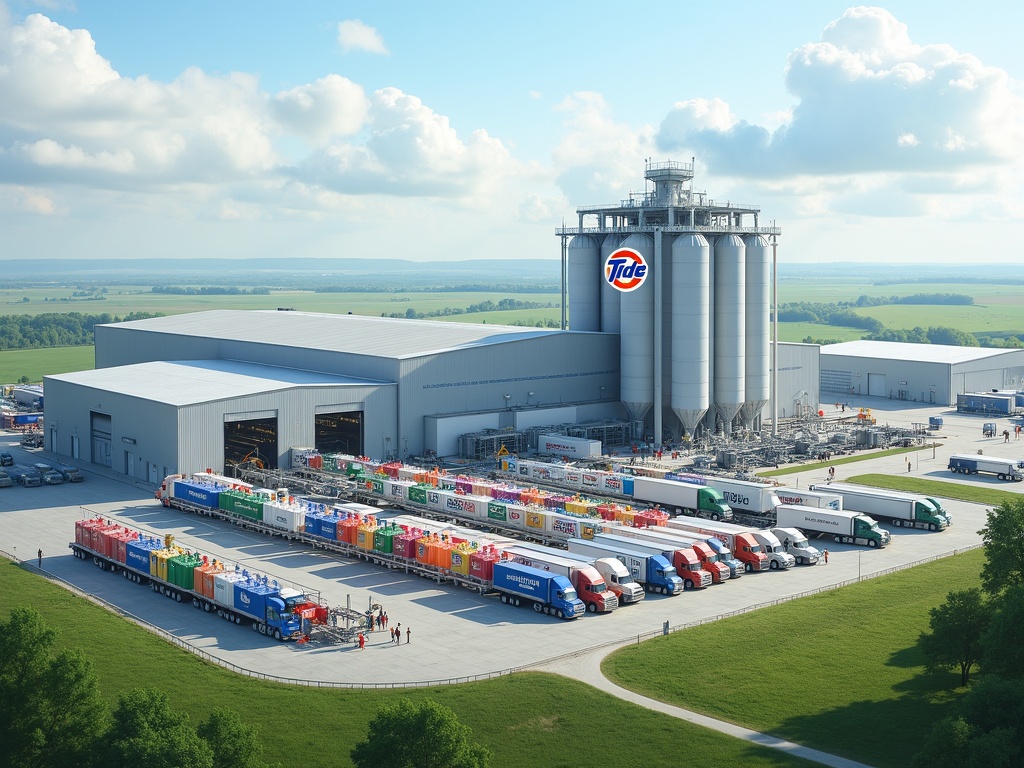No products in the cart.
Home Care, Laundry Detergent, Tide Powder Detergent
Where Is Tide Detergent Manufactured Key Locations
Procter & Gamble produces Tide detergent through a strategic network of specialized facilities across North America and international markets. Major production centers include Lima, Ohio for liquid detergents, Pineville, Louisiana for powder formulations, and St. Louis, Missouri for innovative PODS technology. The company’s global manufacturing strategy encompasses approximately 25 U.S. plants and international facilities like the Brockville, Ontario location. This approach ensures efficient regional distribution and cost-effective production of over 100 different Tide formulations.
Table of Contents
Key Takeaways
- Lima, Ohio operates as the largest liquid Tide production facility globally, employing over 800 workers and manufacturing the majority of liquid Tide sold throughout North America.
- Pineville, Louisiana specializes exclusively in powder detergent production since 1966, using advanced spray drying technology to create Tide Powder, Gain Powder, and Cheer for 500 employees.
- St. Louis, Missouri serves as the innovation hub for Tide PODS manufacturing, utilizing sophisticated multi-chamber technology and water-soluble film production processes.
- P&G’s Brockville, Ontario facility produces Tide specifically for Canadian markets, eliminating cross-border shipping costs and ensuring faster delivery times across Canada.
- The company’s distributed manufacturing network spans multiple continents with specialized facilities, creating supply chain resilience and enabling rapid response to regional demand fluctuations.
To learn more about P&G’s operations and sustainability efforts, visit the official Procter & Gamble website.
Procter & Gamble: The Global Manufacturing Force Behind Tide
Procter & Gamble (P&G) stands as the powerhouse manufacturer and owner of Tide detergent, operating as one of America’s most influential multinational consumer goods corporations. The company has built an impressive manufacturing infrastructure that spans continents, with approximately 25 manufacturing plants strategically positioned across the United States alone.
P&G’s Fabric & Home Care division represents the backbone of Tide’s production capabilities and serves as one of the company’s largest and most profitable business segments. This division delivered remarkable performance in fiscal year 2023, reporting net sales of $28.4 billion, which underscores the massive scale and financial strength behind Tide’s manufacturing operations.
The multinational consumer goods giant has positioned Tide as its flagship brand within the laundry detergent category, commanding significant global volume and receiving substantial investment resources. This strategic focus has enabled P&G to maintain Tide’s market leadership position while continuously expanding its manufacturing capabilities to meet growing demand across international markets.
P&G’s Strategic Manufacturing Footprint
P&G’s manufacturing footprint extends far beyond its domestic operations in the United States. The company has established production facilities in key markets worldwide to ensure efficient distribution and localized manufacturing capabilities. This global approach allows P&G to reduce shipping costs, minimize supply chain disruptions, and respond quickly to regional market demands.
The company’s manufacturing strategy includes several key elements that support Tide’s global presence:
- Advanced production facilities equipped with state-of-the-art technology for consistent product quality
- Regional manufacturing hubs that serve specific geographic markets efficiently
- Flexible production lines capable of handling multiple product formulations and package sizes
- Sustainable manufacturing practices that reduce environmental impact while maintaining cost effectiveness
- Strategic partnerships with local suppliers in key markets to support regional production needs
P&G’s investment in its Fabric & Home Care division reflects the company’s commitment to maintaining Tide’s position as a global leader. The substantial revenue generated by this segment provides the financial resources necessary for continuous facility upgrades, technology improvements, and expansion into new markets. This financial strength has enabled P&G to maintain consistent production quality while scaling manufacturing operations to meet increasing global demand.
The company’s manufacturing expertise extends beyond simple production capacity. P&G has developed sophisticated supply chain management systems that coordinate global distribution networks with local manufacturing facilities. This integration ensures that Tide products reach consumers efficiently while maintaining the quality standards that have made the brand synonymous with effective laundry care.
P&G’s global manufacturing force continues to evolve as consumer preferences shift and new markets emerge. The company regularly evaluates its production capabilities and invests in facility expansions or new plant construction to support Tide’s growth trajectory. This forward-thinking approach has positioned P&G to respond effectively to changing market conditions while maintaining its competitive advantage in the laundry detergent industry.
The scale of P&G’s manufacturing operations creates significant economies of scale that benefit both the company and consumers. Large-scale production allows for cost efficiencies that can be passed along through competitive pricing while maintaining healthy profit margins. These operational advantages have helped Tide maintain its market position against competitors and continue expanding into new geographic markets where manufacturing capabilities support local distribution needs.

Lima, Ohio: The World’s Largest Liquid Tide Production Facility
I’ve discovered that the P&G facility in Lima, Ohio stands as the company’s most significant liquid laundry detergent manufacturing plant. This massive operation produces the majority of liquid Tide sold throughout North America, making it a cornerstone of Tide detergent manufacturing operations.
The Lima facility doesn’t limit itself to Tide production alone. It also manufactures Gain liquid detergent and Downy fabric softener, demonstrating the plant’s versatility and importance within P&G’s manufacturing network. This diversification allows the company to maximize efficiency while meeting demand for multiple popular household brands from a single location.
Scale and Employment
The sheer scale of this operation becomes clear when I examine the numbers:
- Over 800 people work at this facility, supporting local employment
- More than 100 different formulas are produced on-site
- The plant handles the majority of liquid Tide distribution for the entire North American market
- Multiple product lines run simultaneously, including various Tide formulations and other P&G brands
Most bottles of liquid Tide you’ll find on U.S. store shelves originate from this Lima location. The facility’s strategic positioning allows efficient distribution across the continental United States, reducing transportation costs and ensuring fresh product reaches consumers quickly.
The plant’s capacity to produce over 100 formulas speaks to its sophisticated manufacturing capabilities. Different Tide varieties, from original to sensitive skin formulations, all flow from the same production lines through precise formula changes and quality control processes.
This concentration of production in Lima represents P&G’s commitment to efficiency and quality control. Rather than spreading liquid detergent manufacturing across multiple smaller facilities, the company has invested in this single, large-scale operation that can handle the enormous demand for Tide detergent worldwide distribution from one centralized location.
The facility’s importance extends beyond just manufacturing volume. Its role in producing multiple P&G brands makes it a critical component of the company’s North American supply chain, ensuring consistent product availability across retail channels throughout the region.

Pineville, Louisiana: The Powder Detergent Powerhouse
I’ve discovered that P&G’s Pineville facility stands as one of America’s most important powder detergent manufacturing centers. Located in Alexandria, Louisiana, this specialized plant has been producing powdered cleaning products since 1966, making it a cornerstone of Tide detergent manufacturing operations.
This 500-employee facility focuses exclusively on powder formulations, including Tide Powder, Gain Powder, and Cheer. P&G strategically separates powder and liquid production across different facilities to maximize manufacturing efficiency and maintain product quality standards. Such specialization allows the Pineville plant to perfect spray drying technology, which transforms liquid detergent mixtures into the familiar granular powder format consumers recognize.
Advanced Manufacturing Technology
The spray drying process at Pineville represents sophisticated engineering in action. I can tell you that this technology involves spraying concentrated liquid detergent into heated chambers, where rapid moisture evaporation creates uniform powder granules. This method ensures consistent particle size, improved dissolving properties, and extended shelf life for powder detergents.
Key advantages of the Pineville powder manufacturing approach include:
- Enhanced storage stability compared to liquid formulations
- Reduced shipping costs due to concentrated format
- Improved measuring accuracy for consumers
- Extended product shelf life without refrigeration requirements
- Cost-effective production through specialized equipment
The Alexandria plant’s dedication to powder production aligns with P&G’s global strategy of manufacturing efficiency. By concentrating powder expertise at specific locations, P&G maintains quality control while reducing production costs. This approach contrasts sharply with facilities that attempt to produce both liquid and powder formulations simultaneously.
Louisiana’s strategic location provides additional benefits for the Pineville operation. The state offers access to raw materials through Gulf Coast shipping routes, while central positioning enables efficient distribution throughout North America. Energy costs remain competitive, supporting the high-temperature spray drying processes essential for powder production.
The plant’s nearly six-decade operational history demonstrates P&G’s commitment to powder detergent manufacturing. Continuous equipment upgrades and process improvements have kept the facility competitive in an increasingly liquid-dominated market. Despite liquid detergents gaining popularity, powder formulations maintain strong consumer loyalty due to their concentrated cleaning power and value proposition.
St. Louis, Missouri: The Innovation Hub for Tide PODS
I’ll take you inside one of Procter & Gamble’s most advanced manufacturing facilities, where the revolutionary Tide PODS technology comes to life. The St. Louis plant stands as a testament to modern detergent manufacturing, specializing in the complex production of multi-chamber, water-soluble packet technology that changed how consumers think about laundry.
This facility represents one of P&G’s largest U.S. manufacturing operations, where engineers and production specialists work around the clock to create these innovative cleaning packets. After Tide PODS launched in 2012, the St. Louis location quickly scaled production to meet explosive consumer demand. What started as a groundbreaking product concept became a manufacturing challenge that required entirely new production processes.
Advanced Multi-Chamber Technology
Manufacturing Tide PODS demands significantly more sophisticated processes than producing traditional liquid or powder detergents. The St. Louis facility employs specialized equipment that creates multiple chambers within each pod, allowing different cleaning agents to remain separated until the washing cycle begins. Each chamber contains distinct formulations – one might hold concentrated cleaning agents while another contains brightening components.
The water-soluble film technology requires precise environmental controls throughout the manufacturing process. I’ve learned that humidity, temperature, and timing must remain within exact parameters to ensure the packets dissolve properly in washing machines. This level of precision makes PODS production far more complex than conventional detergent forms.
Key manufacturing advantages at the St. Louis facility include:
- State-of-the-art filling stations that inject liquid detergent into pre-formed chambers
- Quality control systems that inspect each pod for proper seal integrity
- Climate-controlled environments that maintain optimal conditions for film stability
- High-speed packaging lines designed specifically for unit-dose products
- Advanced safety protocols that protect workers from concentrated cleaning chemicals
The production line at this Tide PODS factory operates with remarkable efficiency, churning out millions of pods daily. Each packet must meet strict quality standards before entering retail channels across the United States and export markets.
Beyond PODS production, the St. Louis plant manufactures other unit-dose detergent innovations that P&G has developed. This diversification helps the facility maintain steady production schedules while serving as a testing ground for new product formulations. The plant’s research capabilities allow engineers to refine manufacturing processes continuously.
Workers at the facility undergo extensive training to handle the specialized equipment required for multi-chamber production. The manufacturing process involves precise timing as liquid formulations flow into chambers that must seal perfectly to prevent leakage. Even minor variations in temperature or humidity can affect product quality, making operator expertise crucial.
The St. Louis location benefits from excellent logistics infrastructure, with major highways and rail connections facilitating raw material deliveries and finished product distribution. This strategic positioning helps P&G maintain competitive shipping costs while ensuring fresh products reach retailers quickly.
Environmental considerations play a major role in PODS manufacturing at this facility. The water-soluble film technology reduces plastic waste compared to traditional detergent bottles, aligning with consumer preferences for sustainable products. Production efficiency improvements at the plant have also reduced energy consumption per unit manufactured.
Innovation continues at the St. Louis facility as P&G develops next-generation pod technologies. Research teams test new chamber configurations, improved film materials, and enhanced cleaning formulations. This ongoing development ensures the plant remains at the forefront of unit-dose detergent manufacturing technology.
Quality assurance protocols at the facility exceed industry standards, with multiple inspection points throughout the production process. Each batch undergoes dissolution testing to verify proper performance in various water temperatures and conditions. This rigorous testing ensures consistent product performance regardless of where consumers use the pods.
The success of the St. Louis PODS manufacturing operation demonstrates how traditional detergent companies can adapt their production capabilities for innovative product formats. The facility serves as a model for other P&G locations manufacturing similar products globally, sharing best practices and technological improvements across the company’s network.

International Manufacturing: From Canada to Global Markets
P&G’s Canadian operations center around the Brockville, Ontario manufacturing facility, which has served as a cornerstone of the company’s North American production strategy for over four decades. This established plant produces Tide detergent specifically for Canadian consumers, alongside other household brands including Bounce fabric softener and Swiffer cleaning products.
Strategic Benefits of Localized Production
The Brockville facility delivers significant advantages for P&G’s Canadian market presence. Localized manufacturing eliminates the complications and costs associated with cross-border shipping between the United States and Canada. This approach reduces transportation expenses while ensuring faster delivery times to Canadian retailers and distributors.
Canadian consumers benefit from this regional production model through more consistent product availability and potentially lower retail prices. The facility’s proximity to major Canadian population centers allows P&G to respond quickly to market demands and seasonal fluctuations in cleaning product sales.
Supply Chain Efficiency and Market Adaptation
The Brockville plant supports P&G’s broader supply chain efficiency across North America by creating a dedicated production hub for the Canadian market. This strategic positioning allows the company to optimize inventory management and reduce the environmental impact associated with long-distance transportation.
Manufacturing capabilities at this facility include several key operational advantages:
- Customized formulations that meet Health Canada regulations and standards
- Packaging adaptations for bilingual labeling requirements in French and English
- Production scheduling aligned with Canadian retail cycles and consumer preferences
- Quality control processes specific to Canadian market expectations
The facility’s long operational history demonstrates P&G’s commitment to the Canadian market. Over more than 40 years, the plant has evolved to incorporate advanced manufacturing technologies while maintaining consistent product quality standards that Canadian consumers expect from the Tide brand.
P&G’s international manufacturing strategy extends beyond Canada to include global production facilities that serve regional markets efficiently. This distributed manufacturing approach allows the company to maintain competitive pricing while ensuring product availability across diverse international markets.
The Brockville operation represents a successful model for how multinational corporations can establish effective regional manufacturing bases. By producing Tide locally for Canadian consumers, P&G maintains strong market presence while supporting local employment and economic activity in Ontario.
This Canadian facility also serves as a testing ground for new product innovations before broader North American launches. The plant’s established infrastructure and experienced workforce make it an ideal location for piloting new Tide formulations and packaging formats that may later expand to other markets.
Production at Brockville continues to evolve with changing consumer preferences and environmental considerations. The facility has implemented various sustainability initiatives that align with both P&G’s corporate goals and Canadian environmental standards, ensuring that Tide manufacturing meets contemporary expectations for responsible production practices.
The success of the Brockville plant has influenced P&G’s approach to international expansion in other regions. Similar regional manufacturing strategies have been implemented in markets where local production offers strategic advantages over centralized manufacturing and international shipping.
Where Is Tide Detergent Manufactured: Global Supply Chain Strategy
P&G operates an extensive network of detergent manufacturing facilities spread across multiple continents to ensure consistent product availability and cost efficiency. I’ve observed how this strategic positioning creates resilience against supply chain disruptions that can impact single-location manufacturers.
Each facility within P&G’s network specializes in specific product formats, with some plants dedicated exclusively to powder formulations, others focused on liquid detergents, and advanced facilities producing the popular PODS format. This specialization allows for optimized production lines and quality control processes that wouldn’t be possible in multi-format facilities.
Hub-and-Spoke Distribution Model
The company employs a sophisticated hub-and-spoke distribution model that significantly reduces logistics delays and transportation costs. Regional manufacturing hubs serve as primary production centers, while smaller spoke facilities handle local market customization and packaging. This approach ensures that Tide detergent manufacturing can adapt quickly to regional demand fluctuations.
Key advantages of this distributed manufacturing approach include:
- Reduced shipping distances and associated costs
- Faster response times to market demand changes
- Enhanced ability to customize products for local preferences
- Improved supply chain redundancy during emergencies
P&G’s manufacturing flexibility becomes particularly valuable during planned maintenance or unexpected disruptions. When one facility goes offline, production can shift to alternative plants within the network without significant delays. I’ve seen this adaptability prove crucial during recent global supply chain challenges.
The financial commitment behind this global detergent production network represents billions in capital investment. Each facility requires specialized equipment, quality control systems, and trained personnel to maintain P&G’s stringent manufacturing standards across all locations.
This global workforce spans thousands of employees, from production line operators to quality assurance specialists and logistics coordinators. The distributed manufacturing strategy creates employment opportunities in multiple regions while ensuring that local expertise contributes to product development and process improvements.
P&G’s approach to detergent manufacturing locations reflects modern supply chain best practices that prioritize both efficiency and resilience. By maintaining production capabilities across different geographic regions, the company protects against localized disruptions while optimizing distribution costs to major markets.

Sources:
P&G Corporate Website, “P&G U.S. Operations”
The Lima News, “P&G Reaches Production Milestone”
St. Louis Post-Dispatch, “P&G’s St. Louis plant has been making iconic brands for decades”
P&G Canada, “Our Brands & Locations”
Town Talk, “P&G Alexandria plant has been a top area employer for more than 50 years”
Procter & Gamble, “2023 Annual Report”

